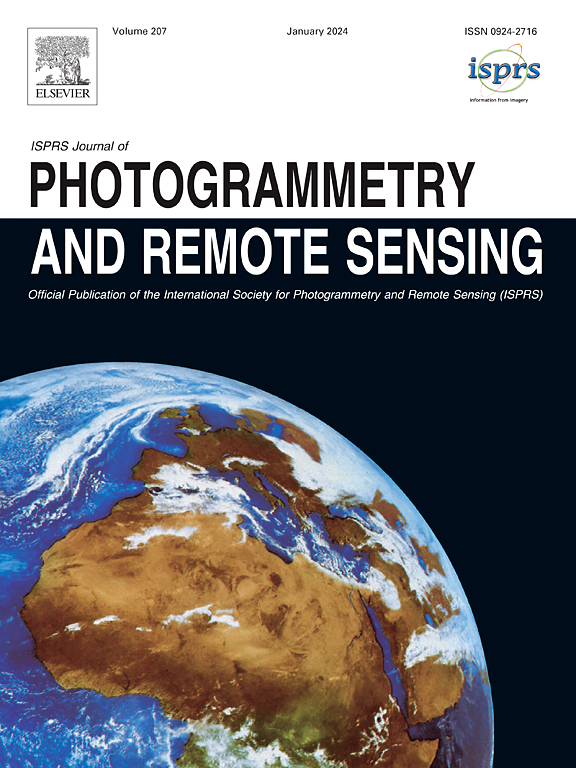Combining optical and SAR satellite data to monitor coastline changes in the Black Sea
IF 10.6
1区 地球科学
Q1 GEOGRAPHY, PHYSICAL
ISPRS Journal of Photogrammetry and Remote Sensing
Pub Date : 2025-05-15
DOI:10.1016/j.isprsjprs.2025.05.003
引用次数: 0
Abstract
The coastal environments of the Black Sea are of high ecological and socio-economic importance. Understanding changes along this extensive and complex coastline can help us comprehend the pressures from nature, society, and extreme events, providing valuable insights for more effective management and the prevention of future adverse changes. Current methods for monitoring coastal dynamics rely on the accurate extraction of coastlines from optical and/or Synthetic Aperture Radar (SAR) images, providing information only on the rate of change. This study developed a simple yet novel approach by combining Sentinel-1 SAR image for surface change detection and Sentinel-2 Multispectral Instrument (MSI) optical image for coastline detection, which provides data on both the rate and area of change. Coastlines were extracted from the Modified Normalised Difference Water Index (MNDWI) calculated from MSI images and rates of change were calculated from the extracted coastlines. SAR images for the same areas were stacked and differences during the analysis period were calculated, allowing the determination of the area of change. Another new method was developed to combine the changes detected from optical and SAR images, and only results in locations showed consistent change direction (erosion or accretion) were retained. The extracted coastlines were validated using in situ-measured coastlines along the Romanian and Georgian coasts. The validation analysis showed that the average difference between satellite-derived and in situ coastlines was 11.8 m. The method developed was then applied to the entire Black Sea coast, revealing 35.1 km2 of changes between 2016 and 2023. These observed changes include 23.9 km2 (68 %) coastal advance and 11.3 km2 (32 %) of retreat. A total of 54 % of the changes are estimated to be the result of natural coastline erosion or accretion, whilst 35 % can be attributed to artificial changes related to construction activity. Around 11 % are attributed to random occurrences due to boat/ship movement or land cover changes on adjacent land. Natural coastline changes were mainly observed in the vicinity of deltaic and estuarine system and along sandy shorelines, including along the Danube Delta, Kızılırmak-Yeşilırmak deltas, Chorokhi-Rioni-Kodori River mouths and the coast from Dnieper-Bug Estuary to Karkinit Bay. Artificial changes were mainly found along the southern Black Sea coast, where airports, ports, harbours, and jetties have been constructed in recent years. The proposed method provides a simple, efficient and accurate way for coastline change monitoring, and findings in this study can support the sustainable coastal zone management in the Black Sea.
结合光学和SAR卫星数据监测黑海海岸线变化
黑海沿岸环境具有高度的生态和社会经济重要性。了解这条广阔而复杂的海岸线的变化可以帮助我们理解来自自然、社会和极端事件的压力,为更有效的管理和预防未来的不利变化提供有价值的见解。目前监测海岸动态的方法依赖于从光学和/或合成孔径雷达(SAR)图像中精确提取海岸线,只提供关于变化速度的信息。该研究开发了一种简单而新颖的方法,将用于地表变化检测的Sentinel-1 SAR图像和用于海岸线检测的Sentinel-2多光谱仪器(MSI)光学图像结合起来,提供了变化速率和面积的数据。从MSI图像计算的修正归一化差水指数(MNDWI)中提取海岸线,并根据提取的海岸线计算变化率。将同一区域的SAR图像进行叠加,计算分析期间的差异,从而确定变化面积。研究人员开发了另一种新方法,将光学和SAR图像检测到的变化结合起来,只保留了显示一致变化方向(侵蚀或增生)的位置的结果。提取的海岸线使用罗马尼亚和格鲁吉亚海岸沿线的现场测量海岸线进行验证。验证分析表明,卫星导出的海岸线与原位海岸线之间的平均差异为11.8米。然后将开发的方法应用于整个黑海海岸,揭示了2016年至2023年间35.1平方公里的变化。这些观测到的变化包括23.9平方公里(68%)的海岸推进和11.3平方公里(32%)的退缩。据估计,总共54%的变化是自然海岸线侵蚀或增生的结果,而35%可归因于与建筑活动有关的人为变化。大约11%归因于船/船运动或邻近陆地上土地覆盖变化引起的随机事件。自然海岸线变化主要发生在三角洲和河口体系附近及砂质岸线沿线,包括多瑙河三角洲、Kızılırmak-Yeşilırmak三角洲、Chorokhi-Rioni-Kodori河口和第聂伯河河口至Karkinit湾沿岸。人为的变化主要发生在黑海南部海岸,那里近年来修建了机场、港口、港口和码头。该方法为黑海岸线变化监测提供了一种简单、高效、准确的方法,研究结果可为黑海岸带的可持续管理提供支持。
本文章由计算机程序翻译,如有差异,请以英文原文为准。
求助全文
约1分钟内获得全文
求助全文
来源期刊

ISPRS Journal of Photogrammetry and Remote Sensing
工程技术-成像科学与照相技术
CiteScore
21.00
自引率
6.30%
发文量
273
审稿时长
40 days
期刊介绍:
The ISPRS Journal of Photogrammetry and Remote Sensing (P&RS) serves as the official journal of the International Society for Photogrammetry and Remote Sensing (ISPRS). It acts as a platform for scientists and professionals worldwide who are involved in various disciplines that utilize photogrammetry, remote sensing, spatial information systems, computer vision, and related fields. The journal aims to facilitate communication and dissemination of advancements in these disciplines, while also acting as a comprehensive source of reference and archive.
P&RS endeavors to publish high-quality, peer-reviewed research papers that are preferably original and have not been published before. These papers can cover scientific/research, technological development, or application/practical aspects. Additionally, the journal welcomes papers that are based on presentations from ISPRS meetings, as long as they are considered significant contributions to the aforementioned fields.
In particular, P&RS encourages the submission of papers that are of broad scientific interest, showcase innovative applications (especially in emerging fields), have an interdisciplinary focus, discuss topics that have received limited attention in P&RS or related journals, or explore new directions in scientific or professional realms. It is preferred that theoretical papers include practical applications, while papers focusing on systems and applications should include a theoretical background.
 求助内容:
求助内容: 应助结果提醒方式:
应助结果提醒方式:


